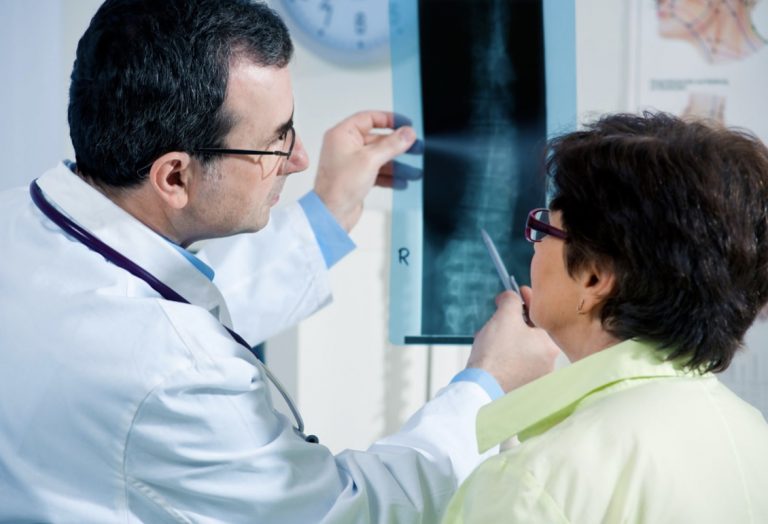A collapsed disc describes a condition where one of the rubbery discs in the spinal column loses its height. As a result, the surrounding vertebrae become compressed and can potentially cause painful symptoms. Since these discs are responsible for cushioning the spine, allowing us to bend and flex, loss of disc height can be highly debilitating and can disrupt the function of our spinal column.
If you or a loved one has been diagnosed with a collapsed disc, or are researching potential causes of neck or back pain, learning more about treatment can help you as you seek relief. Although spine conditions can have very troubling symptoms, lasting relief is possible and educating yourself on your condition is a great first step.
The BEST Health System team is dedicated to providing patients with the most effective, least invasive treatment plan. If you are looking to learn more about collapsed discs and potential treatment options available through BEST, continue reading.
- Collapsed Discs are Commonly Caused by the Natural Aging Process
A collapsed disc is most commonly associated with an age-related condition called degenerative disc disease. This is a very common condition, affecting well over half the population over the age of 60. Degenerative disc disease develops essentially because our bodies tend to dry out and lose elasticity as we get older.
For the discs in our spine, which are primarily made of an outer layer of cartilage and gel-like interior, these effects of the aging process can cause a number of problems. A collapsed disc occurs when the loss of elasticity and brittleness causes one or more spinal discs to become thin and lose height.
It is possible to have a collapsed disc without experiencing symptoms. Like other spine conditions, pain and other problems are most often the result of the compression of the spinal nerves. In the case of a collapsed disc, this can happen when the decreased disc space narrows nerve pathways, which can put pressure on the nerves and cause the following symptoms:
- Localized and radiating pain
- Tingling and numbness
- Muscle weakness
- Collapsed Disc and Degenerative Disc Disease are Not Curable, But They are Treatable
Patients typically receive a diagnosis of a collapsed disc from a physician after undergoing an evaluation to determine the source of the above symptoms. Since the condition is age-related, our spinal discs cannot regenerate. This makes the primary goal of treatment symptoms management and attempting to slow down the progression as much as possible.
Effective treatments vary but most patients first work with their doctor to develop a care plan based on a combination of healthy lifestyle choices and conservative treatments.
- Focusing on a Healthy Lifestyle Can Help
Our spine is built to withstand an enormous amount of pressure on a daily basis. Not only does it support the upper body and head, but it also protects the spinal cord and nerve roots while being flexible enough to bend and twist. Although there is no way to reverse the aging process that leads to a collapsed disc, taking steps to relieve pressure on your spinal column can help with both prevention and treatment.
Patients with a collapsed disc or other degenerative spine condition often take the following doctor-recommended steps to promote spine health:
- Improve posture to evenly distribute weight on the spine
- Eat a healthy diet with nutrient-rich, anti-inflammatory foods
- Get regular exercise to strengthen muscles and improve cardiovascular health
- Quit smoking, if necessary
- Start a weight management program, if weight is the predominant issue
Many patients dealing with a collapsed disc are surprised by the positive effects that come from practicing a spine-healthy lifestyle. Even patients who need to eventually undergo surgery, long-term positive outcomes are often dependent on following these guidelines.
- A Collapsed Disc Diagnosis Does Not Mean Surgery – Conservative Treatments are Often Effective
Upon initial diagnosis of a collapsed disc, physicians will begin with a course of nonsurgical treatments that can complement the above lifestyle recommendations. The most common options are over-the-counter pain relievers or anti-inflammatories, physical therapy, periods of rest, and therapeutic injections.
It can take some time to find the right combination of treatments, but symptom relief that allows for a good quality of life and the ability to perform daily activities is often possible. It is important to take a proactive approach and find treatment professionals who you can collaborate with.
- Collapsed Disc Surgery Does Not Mean Hospitalization
If weeks or months of conservative treatment is not sufficient in achieving lasting relief for collapsed disc symptoms, it may be time to consult with a spine surgeon. Many patients with spine conditions are hesitant at the prospect of spine surgery due to the highly invasive nature of traditional open spine surgery. Another concern is the risk of hospital-associated infection due to the proximity of patients with infectious diseases.
Fortunately, advancements in technology and technique in spine surgery has allowed for the development of minimally invasive outpatient spine surgery. These procedures require a small incision, often less than one inch, and muscle-sparing techniques. The result is an outpatient experience with less risk of complication and a shorter recovery time compared to traditional open spine surgery.
Reach out to BEST Health System
If you are interested in learning more about the minimally invasive spine procedures offered through BEST Health Care, connect with our team today! Take the first step on your path to recovery. The BEST is yet to come.
